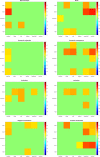Bodily sensations in social scenarios: Where in the body?
- PMID: 31185013
- PMCID: PMC6559636
- DOI: 10.1371/journal.pone.0206270
Bodily sensations in social scenarios: Where in the body?
Abstract
Bodily states are fundamental to emotions' emergence and are believed to constitute the first step in the chain of events that culminate in emotional awareness. Recent works have shown that distinct topographical maps can be derived to describe how basic and more complex emotions are represented in the body. However, it is still unclear whether these bodily maps can also extend to emotions experienced specifically within social interactions and how these representations relate to basic emotions. To address this issue, we used the emBODY tool to obtain high-resolution bodily maps that describe the body activation and deactivation experienced by healthy participants when presented with social scenarios depicting establishment or loss of social bonds. We observed patterns of activation/deactivation for each single social scenario depending on the valence, but also a common activation of head, chest and deactivation of limbs for positive and negative social scenarios, respectively. Furthermore, we show that these maps are comparable to those obtained when taking the perspective of a third person, suggesting the existence of common body representation of social emotions for the self and other person evaluation. Finally, we showed that maps related to complex social scenarios are strongly correlated with bodily states experienced in basic emotions, suggesting that the patterns of body activation/deactivation observed for social scenarios might arise from a complex interaction of the basic emotions that these experiences elicit.
Conflict of interest statement
The authors have declared that no competing interests exist.
Figures






Similar articles
-
Bodily maps of emotions across child development.Dev Sci. 2016 Nov;19(6):1111-1118. doi: 10.1111/desc.12389. Epub 2016 Feb 21. Dev Sci. 2016. PMID: 26898716
-
Anomalous Bodily Maps of Emotions in Schizophrenia.Schizophr Bull. 2019 Sep 11;45(5):1060-1067. doi: 10.1093/schbul/sby179. Schizophr Bull. 2019. PMID: 30551180 Free PMC article.
-
Bodily Maps of Symptoms and Emotions in Parkinson's Disease.Mov Disord. 2024 Jun;39(6):1037-1043. doi: 10.1002/mds.29785. Epub 2024 Apr 8. Mov Disord. 2024. PMID: 38586892
-
The Social Neuroscience of Interpersonal Emotions.Curr Top Behav Neurosci. 2017;30:241-256. doi: 10.1007/7854_2016_437. Curr Top Behav Neurosci. 2017. PMID: 26946503 Review.
-
Explaining the felt location of bodily sensations through body representations.Conscious Cogn. 2018 Apr;60:17-24. doi: 10.1016/j.concog.2018.01.007. Epub 2018 Mar 5. Conscious Cogn. 2018. PMID: 29518626 Review.
Cited by
-
The positive energy of netizens: development and application of fine-grained sentiment lexicon and emotional intensity model.Curr Psychol. 2022 Nov 3:1-18. doi: 10.1007/s12144-022-03876-4. Online ahead of print. Curr Psychol. 2022. PMID: 36345548 Free PMC article.
-
Where is emotional feeling felt in the body? An integrative review.PLoS One. 2021 Dec 22;16(12):e0261685. doi: 10.1371/journal.pone.0261685. eCollection 2021. PLoS One. 2021. PMID: 34936672 Free PMC article. Review.
-
Bodily expression of psychological distress in adolescents: a qualitative study.Child Adolesc Psychiatry Ment Health. 2022 Jun 3;16(1):40. doi: 10.1186/s13034-022-00476-9. Child Adolesc Psychiatry Ment Health. 2022. PMID: 35659270 Free PMC article.
-
Ready-made bodily sensations.Sci Rep. 2025 Aug 18;15(1):30223. doi: 10.1038/s41598-025-14061-5. Sci Rep. 2025. PMID: 40825803 Free PMC article.
-
The utility of the emBODY tool as a novel method of studying complex phenomena-related emotions.Sci Rep. 2022 Nov 18;12(1):19884. doi: 10.1038/s41598-022-23734-4. Sci Rep. 2022. PMID: 36400810 Free PMC article.
References
-
- Brewer MB. Taking the social origins of human nature seriously: toward a more imperialist social psychology. Personality and social psychology review: an official journal of the Society for Personality and Social Psychology, Inc. 2004;8(2):107–13. - PubMed

